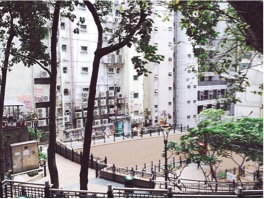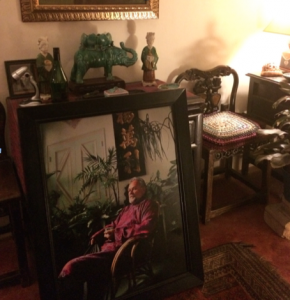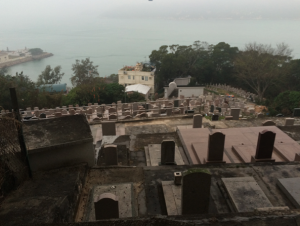I was in Hong Kong at the start of recess week. For the first time in this exceptionally compact city, I’ve started noticing slopes, walls, street trees, light, pigeons and canals. I kept stopping to take pictures of cascading roots, drains and moss lining the stone cobbled streets; I think my friend travelling with me was slightly disgusted. Most of what I saw was talked about in class. I would just like to mention this “Wind Power Generation System” spotted on a small rooftop near the harbor at the IFC (on HK Island):
A quick search on the internet later, these micro wind turbines are likely to be test installations- small enough for private use. Can this is a possible application for Singapore as well, given the substantial number of rooftop space available?
Another feature of the dense city I noticed only during this trip was the green pockets in the city:
We talked about green spaces in urban areas in class; these green spaces in HK are I think created for pragmatic amenity use, rather than an environmental function (i.e. ecosystem services). I see old men playing chess, people working out, using the ‘stone floor’, children at playgrounds etc. It is almost like an extended living room for residents in surrounding cramped apartments. I wonder if these spaces contributed to a more environment friendly attitude in its residents too, for example, every shop assumes I will not be taking a plastic bag for my purchases.
Cheung Chau
I was lucky to get to visit an extended family member Uncle Eugen on the island of Cheng Chau (a 45 minute ride on Star Ferry). A quick introduction to Cheung Chau (I took from one of the information boards scattered around the island put up by DiscoverHongKong):
“Cheung Chau was, until recently, a very important fishing port. In 1911, there were 900 trawlers here, and a population of more than 8000 people. The town was founded in the late 17th century, reflecting the development of a commercial fishing industry in the area. The town flourished by serving the fishing fleet, and by drying and shipping huge catches of fish to inland destinations. The island become home to a suburban population as early as the 1920s. In recent years, this community has grown substantially. The island has no less than seven temples of which the largest, Pak Tai Temple, is particularly magnificent.” – DiscoverHongKong
Uncle Eugen has lived on the island for 27 years. He is an antiquities dealer and restorer, an expert in Asian and Middle Eastern history and antiques. I spent the day listening to his stories of how the island has changed from a sleepy fishing village to a weekend getaway for mainland tourists. Here are some pictures to give you a rough idea of the built up area on the island:
Everyone has to walk or cycle in Cheng Chau, there are no vehicles and even electric bikes are not allowed (the only exception are electric fire trucks, police vans and ambulances specially made for the narrow lanes). The wind blows the pollution from Shenzhen and HK Island, so it is not exempt from the dangers of air pollution. Right next to his house, there is a small temple with a cherry blossom tree, which brings in droves of tourists. It was brought to Taiwan by the Japanese and shipped over to Cheung Chau. I thought it was an apt metaphor: Uncle Eugen who was originally from Australia was just like the exotic species of the cherry blossom tree; both have been on the island for decades and integrated so well into the native habitat, you could hardly tell them apart from the native species anymore. This is a picture of a picture of Uncle Eugen in his house and the cherry blossom tree:
Not all exotic species are ‘bad’!
I walked up the hills at the northern end and came across a cemetery:
According to Uncle Eugen, in the past the people from mainland or HK Island could bury their dead on Cheung Chau because the “Feng Shui” on the island is ideal. However, now only island residents are allowed to be buried on the island AND the new regulations state after 7 years, bodies have to be exhumed and replaced into urns or more compact burial grounds. Would Singapore have to resort to this in the future as we run out of space?
On my walk, I also spotted tagged trees on slopes that were roped off and stone/concrete built into steep slopes along the pathway:
Trees are tagged and roped off- the department tracks the felling of trees to ensure integrity of the slopes. Stone/concrete walls are built along pathways to prevent mudslides etc. Because of the hilly nature of the island (similarly on HK island), slope maintenance is a major part of ecological maintenance done by the agricultural services department of Hong Kong.
The island is, to a large part, self-sustainable. The food is either grown on the island, fished from the surrounding ocean or conveniences brought from the mainland. Water comes from nearby Lan Tau Island or collected from a reservoir on the hilltops. Fisherman and local mom-and-pop stores fuel the economy. As I walked around the island, there were numerous tiny shops selling knick-knacks, tea slabs and tiny cramped restaurants. Because the northern and southern ends of the island are hilly, the main settlements are situated at the thinnest part (the tombolo). Here is a picture of the island map: it is shaped like the figure 8 (formed from two masses joined by a tumble where the main streets, ferry/fishing harbor and biggest temple is located):
Apparently, the residential and commercial rents have increased over the past year, due to the influx of tourism and mainlanders heading here to escape the high rates in the urban core. Besides the MacDonalds booth greeting you as you disembark the ferry, Cheung Chau is pretty much a throwback to basic, almost rural, living. But as space runs out, will the mainland start to eye the islands as potential for development? Will we see a urban to rural move? Before that happens, I hope you guys get the chance to visit!










